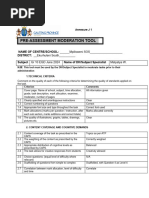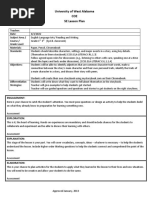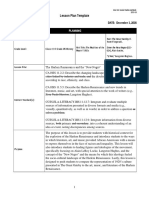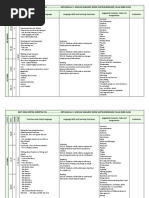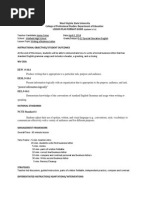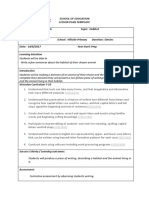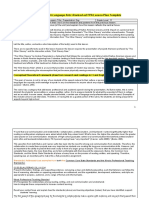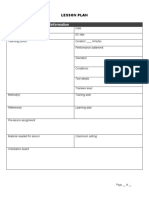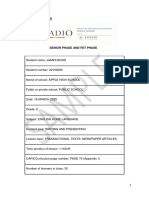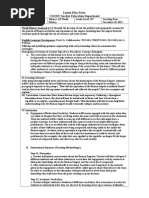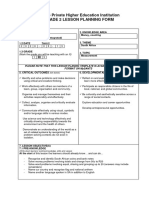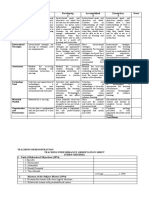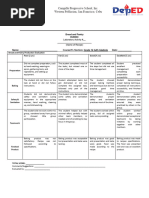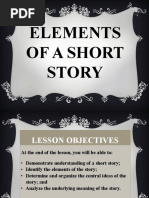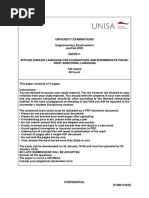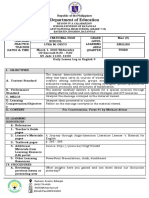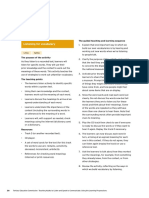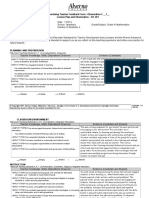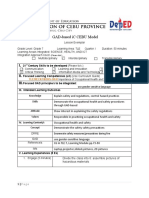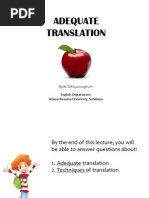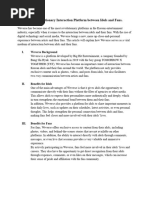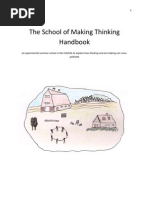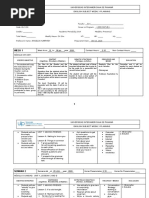GCU Lesson Plan Template
GCU Lesson Plan Template
Uploaded by
Keyania MurrayCopyright:
Available Formats
GCU Lesson Plan Template
GCU Lesson Plan Template
Uploaded by
Keyania MurrayOriginal Title
Copyright
Available Formats
Share this document
Did you find this document useful?
Is this content inappropriate?
Copyright:
Available Formats
GCU Lesson Plan Template
GCU Lesson Plan Template
Uploaded by
Keyania MurrayCopyright:
Available Formats
GCU College of Education
LESSON PLAN TEMPLATE
Section 1: Lesson Preparation
Teacher Candidate
Name:
Grade Level:
Date:
Unit/Subject:
Instructional Plan Title:
Lesson Summary and In 2-3 sentences, summarize the lesson, identifying the central focus
Focus: based on the content and skills you are teaching.
Classroom and Student Describe the important classroom factors (demographics and
Factors/Grouping: environment) and student factors (IEPs, 504s, ELLs, students with
behavior concerns, gifted learners), and the effect of those factors on
planning, teaching, and assessing students to facilitate learning for all
students. This should be limited to 2-3 sentences and the information
should inform the differentiation components of the lesson.
National/State Learning Review national and state standards to become familiar with the standards
Standards: you will be working with in the classroom environment.
Your goal in this section is to identify the standards that are the focus of
the lesson being presented. Standards must address learning initiatives
from one or more content areas, as well as align with the lesson’s learning
targets/objectives and assessments.
© 2018. Grand Canyon University. All Rights Reserved.
GCU College of Education
LESSON PLAN TEMPLATE
Include the standards with the performance indicators and the standard
language in its entirety.
Specific Learning Learning objectives are designed to identify what the teacher intends to
Target(s)/Objectives: measure in learning. These must be aligned with the standards. When
creating objectives, a learner must consider the following:
Who is the audience
What action verb will be measured during instruction/assessment
What tools or conditions are being used to meet the learning
What is being assessed in the lesson must align directly to the objective
created. This should not be a summary of the lesson, but a measurable
statement demonstrating what the student will be assessed on at the
completion of the lesson. For instance, “understand” is not measureable,
but “describe” and “identify” are.
For example:
Given an unlabeled map outlining the 50 states, students will accurately
label all state names.
Academic Language In this section, include a bulleted list of the general academic vocabulary
and content-specific vocabulary you need to teach. In a few sentences,
describe how you will teach students those terms in the lesson.
© 2018. Grand Canyon University. All Rights Reserved.
GCU College of Education
LESSON PLAN TEMPLATE
Resources, Materials, List all resources, materials, equipment, and technology you and the
Equipment, and students will use during the lesson. As required by your instructor, add or
Technology: attach copies of ALL printed and online materials at the end of this
template. Include links needed for online resources.
Section 2: Instructional Planning
Anticipatory Set Time
Needed
Your goal in this section is to open the lesson by activating students’ prior knowledge, linking
previous learning with what they will be learning in this lesson and gaining student interest for the
lesson. Consider various learning preferences (movement, music, visuals) as a tool to engage
interest and motivate learners for the lesson.
In a bulleted list, describe the materials and activities you will use to open the lesson. Bold any
materials you will need to prepare for the lesson.
For example:
I will use a visual of the planet Earth and ask students to describe what Earth looks
like.
I will record their ideas on the white board and ask more questions about the amount of
water they think is on planet Earth and where the water is located.
Multiple Means of Representation Time
Needed
Learners perceive and comprehend information differently. Your goal in this section is to explain
© 2018. Grand Canyon University. All Rights Reserved.
GCU College of Education
LESSON PLAN TEMPLATE
how you would present content in various ways to meet the needs of different learners. For
example, you may present the material using guided notes, graphic organizers, video or other
visual media, annotation tools, anchor charts, hands-on manipulatives, adaptive technologies,
etc.
In a bulleted list, describe the materials you will use to differentiate instruction and how you will
use these materials throughout the lesson to support learning. Bold any materials you will need
to prepare for the lesson.
For example:
I will use a Venn diagram graphic organizer to teach students how to compare and
contrast the two main characters in the read-aloud story.
I will model one example on the white board before allowing students to work on the
Venn diagram graphic organizer with their elbow partner.
Explain how you will differentiate materials for each of the following groups:
English language learners (ELL):
Students with special needs:
Students with gifted abilities:
Early finishers (those students who finish early and may need additional
resources/support):
Multiple Means of Engagement Time
Needed
Your goal for this section is to outline how you will engage students in interacting with the content
and academic language. How will students explore, practice, and apply the content? For
© 2018. Grand Canyon University. All Rights Reserved.
GCU College of Education
LESSON PLAN TEMPLATE
example, you may engage students through collaborative group work, Kagan cooperative
learning structures, hands-on activities, structured discussions, reading and writing activities,
experiments, problem solving, etc.
In a bulleted list, describe the activities you will engage students in to allow them to explore,
practice, and apply the content and academic language. Bold any activities you will use in the
lesson. Also, include formative questioning strategies and higher order thinking questions you
might pose.
For example:
I will use a matching card activity where students will need to find a partner with a card
that has an answer that matches their number sentence.
I will model one example of solving a number sentence on the white board before having
students search for the matching card.
I will then have the partner who has the number sentence explain to their partner how
they got the answer.
Explain how you will differentiate activities for each of the following groups:
English language learners (ELL):
Students with special needs:
Students with gifted abilities:
Early finishers (those students who finish early and may need additional
resources/support):
© 2018. Grand Canyon University. All Rights Reserved.
GCU College of Education
LESSON PLAN TEMPLATE
Multiple Means of Expression Time
Needed
Learners differ in the ways they navigate a learning environment and express what they know.
Your goal in this section is to explain the various ways in which your students will demonstrate
what they have learned. Explain how you will provide alternative means for response, selection,
and composition to accommodate all learners. Will you tier any of these products? Will you offer
students choices to demonstrate mastery? This section is essentially differentiated assessment.
In a bulleted list, explain the options you will provide for your students to express their knowledge
about the topic. For example, students may demonstrate their knowledge in more summative
ways through a short answer or multiple-choice test, multimedia presentation, video, speech to
text, website, written sentence, paragraph, essay, poster, portfolio, hands-on project, experiment,
reflection, blog post, or skit. Bold the names of any summative assessments.
Students may also demonstrate their knowledge in ways that are more formative. For example,
students may take part in thumbs up-thumbs middle-thumbs down, a short essay or drawing, an
entrance slip or exit ticket, mini-whiteboard answers, fist to five, electronic quiz games, running
records, four corners, or hand raising. Underline the names of any formative assessments.
For example:
Students will complete a one-paragraph reflection on the in-class simulation they experienced.
They will be expected to write the reflection using complete sentences, proper capitalization and
punctuation, and utilize an example from the simulation to demonstrate their understanding.
Students will also take part in formative assessments throughout the lesson, such as thumbs up-
thumbs middle-thumbs down and pair-share discussions, where you will determine if you need to
re-teach or re-direct learning.
Explain if you will differentiate assessments for each of the following groups:
English language learners (ELL):
Students with special needs:
Students with gifted abilities:
Early finishers (those students who finish early and may need additional
resources/support):
© 2018. Grand Canyon University. All Rights Reserved.
GCU College of Education
LESSON PLAN TEMPLATE
Extension Activity and/or Homework Time
Needed
Identify and describe any extension activities or homework tasks as appropriate. Explain how the
extension activity or homework assignment supports the learning targets/objectives. As required
by your instructor, attach any copies of homework at the end of this template.
Rationale/Reflection
After writing your complete lesson plan, explain three instructional strategies you included in your
lesson and why. How do these strategies promote collaboration, communication, critical thinking,
and creativity? Bold the name of the strategy.
For example:
.
Think-Pair-Share promotes engagement, communication, and collaboration because all
students get a chance to share their ideas or answers. This is beneficial to students
because they get to put their ideas into words, and hear and discuss the perspectives of
others.
© 2018. Grand Canyon University. All Rights Reserved.
You might also like
- J1 Premoderation TemplateDocument2 pagesJ1 Premoderation Templatenathicoka4No ratings yet
- Lesson Plan Gr4 English FAL T1 W1Document11 pagesLesson Plan Gr4 English FAL T1 W1selloselowa6100% (1)
- Parker Et Al 2023 Chatgpt For Automated Writing Evaluation in Scholarly Writing InstructionDocument7 pagesParker Et Al 2023 Chatgpt For Automated Writing Evaluation in Scholarly Writing Instructioncvelizp0No ratings yet
- Sample Semi Detailed OBE Lesson PlanDocument2 pagesSample Semi Detailed OBE Lesson PlanJude Salayo OaneNo ratings yet
- Medgyes, P. (1986) - Queries From A Communicative Teacher.Document6 pagesMedgyes, P. (1986) - Queries From A Communicative Teacher.gabar.coalNo ratings yet
- Hope McDowell ResumeDocument2 pagesHope McDowell ResumeHope McDowellNo ratings yet
- Observation Tool Cot1Document3 pagesObservation Tool Cot1Lea Mae FranciscoNo ratings yet
- University of West Alabama COE 5E Lesson Plan: Teacher: Date: Subject Area / Course / Grade Level: Materials: StandardsDocument2 pagesUniversity of West Alabama COE 5E Lesson Plan: Teacher: Date: Subject Area / Course / Grade Level: Materials: Standardsapi-618311699No ratings yet
- HST Teaching Presentation RubricDocument2 pagesHST Teaching Presentation RubricRamil GofredoNo ratings yet
- Cavalli Itu Lesson PlanDocument15 pagesCavalli Itu Lesson Planapi-340165695No ratings yet
- 2017-2018 5.sınıf Yıllık PlanDocument10 pages2017-2018 5.sınıf Yıllık PlanTNo ratings yet
- Business Letter LessonDocument7 pagesBusiness Letter Lessonapi-294417359No ratings yet
- 103 2019 0 BDocument79 pages103 2019 0 BTeeh Mabhedla Maphisa0% (2)
- Educ 5220 Unit 3 Written AssignmentDocument4 pagesEduc 5220 Unit 3 Written AssignmentChifundoh BandaNo ratings yet
- The Impacts of Modern Technology On Grade 12 StudentsDocument11 pagesThe Impacts of Modern Technology On Grade 12 StudentsJean Lorie May Ibañez83% (6)
- Student Teaching Lesson Plan Evaluation #1Document10 pagesStudent Teaching Lesson Plan Evaluation #1Jacqueline MedinaNo ratings yet
- Lesson Plan 2Document4 pagesLesson Plan 2api-328067798No ratings yet
- Secondary English Language Arts: Revised ed:TPA Lesson Plan TemplateDocument8 pagesSecondary English Language Arts: Revised ed:TPA Lesson Plan Templateapi-341978939No ratings yet
- Rubrics For Lesson Planning OutputDocument4 pagesRubrics For Lesson Planning Outputcewifly13No ratings yet
- Blank Lesson Plan TemplateDocument5 pagesBlank Lesson Plan TemplateBrock RobbinsNo ratings yet
- Lesson Plans For Week 10Document14 pagesLesson Plans For Week 10Jyuber AlvarezNo ratings yet
- Teacher: Graciela Palacios Lesson Title: Revolutionary Women in Latin American History Grade/Subject: Global History 10Document5 pagesTeacher: Graciela Palacios Lesson Title: Revolutionary Women in Latin American History Grade/Subject: Global History 10api-349773715No ratings yet
- SAMPLE LESSON PLAN 1 - ENGLISH - GNWDocument14 pagesSAMPLE LESSON PLAN 1 - ENGLISH - GNWPontsho BolofoNo ratings yet
- Lesson Plan Form CSUDH Teacher Education DepartmentDocument3 pagesLesson Plan Form CSUDH Teacher Education Departmentapi-302414161No ratings yet
- Week 18 Lesson PlansDocument1 pageWeek 18 Lesson Plansapi-279824380No ratings yet
- Lesson Planning Template SNR-FET Mathematics February 2023-1-3Document6 pagesLesson Planning Template SNR-FET Mathematics February 2023-1-3tf9wgz2ysdNo ratings yet
- Lesson Plan ArraysDocument11 pagesLesson Plan ArraysErika MytnikNo ratings yet
- FP South Africa Lesson PlanningDocument8 pagesFP South Africa Lesson PlanningZinhle MthembuNo ratings yet
- 2023 - Things To Consider in Lesson Plan Preparations - Make-Up Assignment - Economics - ECO15M0Document8 pages2023 - Things To Consider in Lesson Plan Preparations - Make-Up Assignment - Economics - ECO15M0kwanelenkosinathi0403No ratings yet
- Lesson Plan & Teaching DemoDocument2 pagesLesson Plan & Teaching DemoRyan B. MaguddayaoNo ratings yet
- Pragmatics Lesson PlanDocument3 pagesPragmatics Lesson PlanmarycarolenefarrenNo ratings yet
- Lesson Plans For Learning SegmentDocument12 pagesLesson Plans For Learning Segmentapi-353068872No ratings yet
- Lesson Plan Evaluation sp16Document5 pagesLesson Plan Evaluation sp16api-28847298No ratings yet
- Co Teaching Lesson Plan Memory MomentDocument5 pagesCo Teaching Lesson Plan Memory Momentapi-385303128No ratings yet
- TPS3704 Portfolio PDF FormatDocument71 pagesTPS3704 Portfolio PDF Formatphilile.mthembuNo ratings yet
- Second Part Teaching and Assessment of GrammarDocument19 pagesSecond Part Teaching and Assessment of GrammarMariter PidoNo ratings yet
- Lesson DevelopmentDocument40 pagesLesson DevelopmentElaigne YeonNo ratings yet
- UbD Lesson Plan For HoverCamsDocument3 pagesUbD Lesson Plan For HoverCamslilyrose6No ratings yet
- DLL-Q2-W1 - Mam LouDocument7 pagesDLL-Q2-W1 - Mam LouChello Ann Pelaez AsuncionNo ratings yet
- B P RubricsDocument7 pagesB P RubricsFrederick John CostasNo ratings yet
- The Story of An HourDocument73 pagesThe Story of An HourRina MacatulaNo ratings yet
- Educ 75Document9 pagesEduc 75Niña Theresa CatimbangNo ratings yet
- Rubric PDFDocument1 pageRubric PDFangeliNo ratings yet
- Poem Grading RubricDocument1 pagePoem Grading Rubrickerrin galvezNo ratings yet
- ENG2611 Jan 2023 Supplementary ExaminationDocument4 pagesENG2611 Jan 2023 Supplementary ExaminationGrace SizaneNo ratings yet
- Eng 9 - DLL - (Wednesday)Document5 pagesEng 9 - DLL - (Wednesday)Lyka Mendoza GuicoNo ratings yet
- 02-Listening For Vocabulary PDFDocument2 pages02-Listening For Vocabulary PDFAulia AlmiraNo ratings yet
- Read TheoryDocument2 pagesRead TheoryAnonymous O2HLZqENo ratings yet
- Lesson Plan 2-Observation and HypothesisDocument6 pagesLesson Plan 2-Observation and Hypothesisapi-656461201No ratings yet
- 201 - Observed Lesson FeedbackDocument4 pages201 - Observed Lesson Feedbackapi-334958359No ratings yet
- DLL - Eng10 - MondayDocument6 pagesDLL - Eng10 - MondayLyka Mendoza GuicoNo ratings yet
- Newsela Lesson PlanDocument2 pagesNewsela Lesson Planapi-355403404No ratings yet
- Lesson Plan 2 UbdDocument3 pagesLesson Plan 2 Ubdapi-341119256No ratings yet
- Unit 3 Lesson 1Document6 pagesUnit 3 Lesson 1Leslie S. AndresNo ratings yet
- Principles of Technology Use in Educational SettingsDocument4 pagesPrinciples of Technology Use in Educational Settingsapi-283025770No ratings yet
- Lesson-ExemplarInterdisciplinary-in-TLE by RELLY ANN DESTURADocument18 pagesLesson-ExemplarInterdisciplinary-in-TLE by RELLY ANN DESTURARelly Ann Destura CapurasNo ratings yet
- Collaborative Planning Template W CaptionDocument5 pagesCollaborative Planning Template W Captionapi-297728751No ratings yet
- ACTION RESEARCH OUTLINE - La Union DivisionDocument1 pageACTION RESEARCH OUTLINE - La Union DivisionMARY JANE R. MACUTAYNo ratings yet
- Unit Learning Plan 1ST QuarterDocument7 pagesUnit Learning Plan 1ST QuarterMaybell GonzalesNo ratings yet
- Norman Robinson Learning Map PPT Week 4 Itl 510Document14 pagesNorman Robinson Learning Map PPT Week 4 Itl 510api-427648228100% (1)
- Coe Lesson Plan TemplateDocument7 pagesCoe Lesson Plan TemplateErica Hardnett AnthonyNo ratings yet
- coe-lesson-plan-templateDocument7 pagescoe-lesson-plan-templatenaniaNo ratings yet
- Clinical Practice 3 Lesson PlanDocument7 pagesClinical Practice 3 Lesson Planapi-708067647No ratings yet
- Institutional Learning Plan: Oxford Louise Academy of Dasma., IncDocument2 pagesInstitutional Learning Plan: Oxford Louise Academy of Dasma., IncBong Relox100% (2)
- PH-PHR212 Lecture 2 FS2021 PDFDocument57 pagesPH-PHR212 Lecture 2 FS2021 PDFIra MoranteNo ratings yet
- Online Assgnmnt 3Document4 pagesOnline Assgnmnt 3Maria ShoukatNo ratings yet
- Rosas-Serrano Vanessa 233386978 Diagnostic-Results Reading 05042021Document14 pagesRosas-Serrano Vanessa 233386978 Diagnostic-Results Reading 05042021api-517983133No ratings yet
- ns2 LteDocument53 pagesns2 LteKashif Amjad100% (1)
- Digital Literacy Skills-Finding, Using, Creating Information and Understanding Digital Practices Not Confident Somewhat Confident Very ConfidentDocument3 pagesDigital Literacy Skills-Finding, Using, Creating Information and Understanding Digital Practices Not Confident Somewhat Confident Very ConfidentJana Luz Dumam-ag PabalayNo ratings yet
- Unit 3 Text 1 Reading Sample Cover LetterDocument3 pagesUnit 3 Text 1 Reading Sample Cover LetterAmandaNo ratings yet
- Sri Ramakrishna Institute of Technology Coimbatore - 10: Transmission SystemDocument14 pagesSri Ramakrishna Institute of Technology Coimbatore - 10: Transmission SystemDr.MARY PRAVEENA SNo ratings yet
- Lecture 2-Adequate TranslationDocument36 pagesLecture 2-Adequate TranslationRida Wahyuningrum Goeridno Darmanto100% (1)
- WEVERSEDocument2 pagesWEVERSEheartalleryNo ratings yet
- Datasheet 2021 CGNV5 SDocument2 pagesDatasheet 2021 CGNV5 Salice castelloNo ratings yet
- Coming Together Is A Beginning. Keeping Together Is Progress. Working Together Is Success.Document6 pagesComing Together Is A Beginning. Keeping Together Is Progress. Working Together Is Success.Duy Vũ AnhNo ratings yet
- ESL Newcomer Outreach Lesson PlansDocument48 pagesESL Newcomer Outreach Lesson PlansNick Cruz100% (2)
- Structured Backbone Design of Computer NetworksDocument44 pagesStructured Backbone Design of Computer Networksrsgk75No ratings yet
- CH 9 Ad Creative Strategy Implementation and EvaluationDocument19 pagesCH 9 Ad Creative Strategy Implementation and EvaluationNikNitu0% (1)
- MSW A4 FormatDocument4 pagesMSW A4 Formatrathish14uNo ratings yet
- Language, Society, and Culture - Exercise and Activity ManualDocument1 pageLanguage, Society, and Culture - Exercise and Activity ManualgedNo ratings yet
- Curriculum Vitae: Full Name Date of Birth Nationality Gender Religion LanguagesDocument3 pagesCurriculum Vitae: Full Name Date of Birth Nationality Gender Religion LanguagesEmmanuel Kikoba100% (1)
- Definition of TranslationDocument17 pagesDefinition of TranslationThauffig ExjerkNo ratings yet
- Velluso - ShareableDocument5 pagesVelluso - Shareableapi-463051896No ratings yet
- Characteristics of A Good LeaderDocument20 pagesCharacteristics of A Good LeaderPrincess TakolkolkolNo ratings yet
- SMT HandbookDocument19 pagesSMT Handbookaaron_finbloomNo ratings yet
- Medical Council Regulation Hgdhof IndonesiaDocument57 pagesMedical Council Regulation Hgdhof IndonesiaChristian Anantha Ginting MuntheNo ratings yet
- Industrial Marketing Management: A B C DDocument12 pagesIndustrial Marketing Management: A B C DMuhammad Miftahul MaulidyNo ratings yet
- English 200 - Iq 2020Document9 pagesEnglish 200 - Iq 2020DuarteDíazNo ratings yet
- Related Reading 1 Literature During Spanish Era (Vinuya 2011)Document1 pageRelated Reading 1 Literature During Spanish Era (Vinuya 2011)Dwight AlipioNo ratings yet
- Drama On Writing PDFDocument8 pagesDrama On Writing PDFIwan SutantoNo ratings yet
